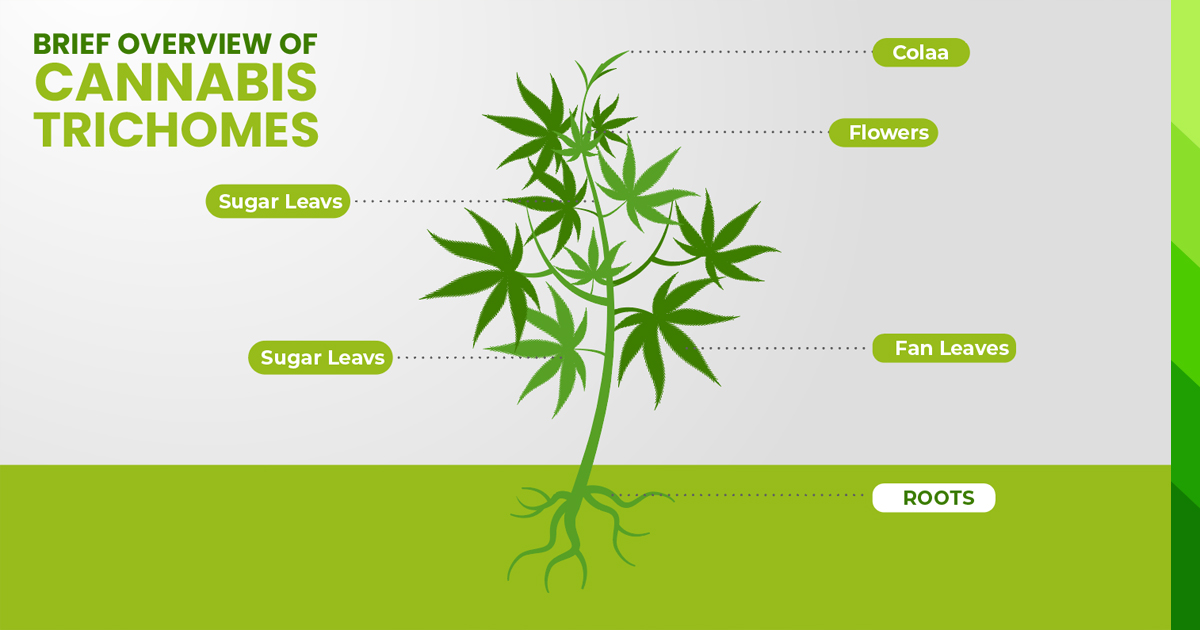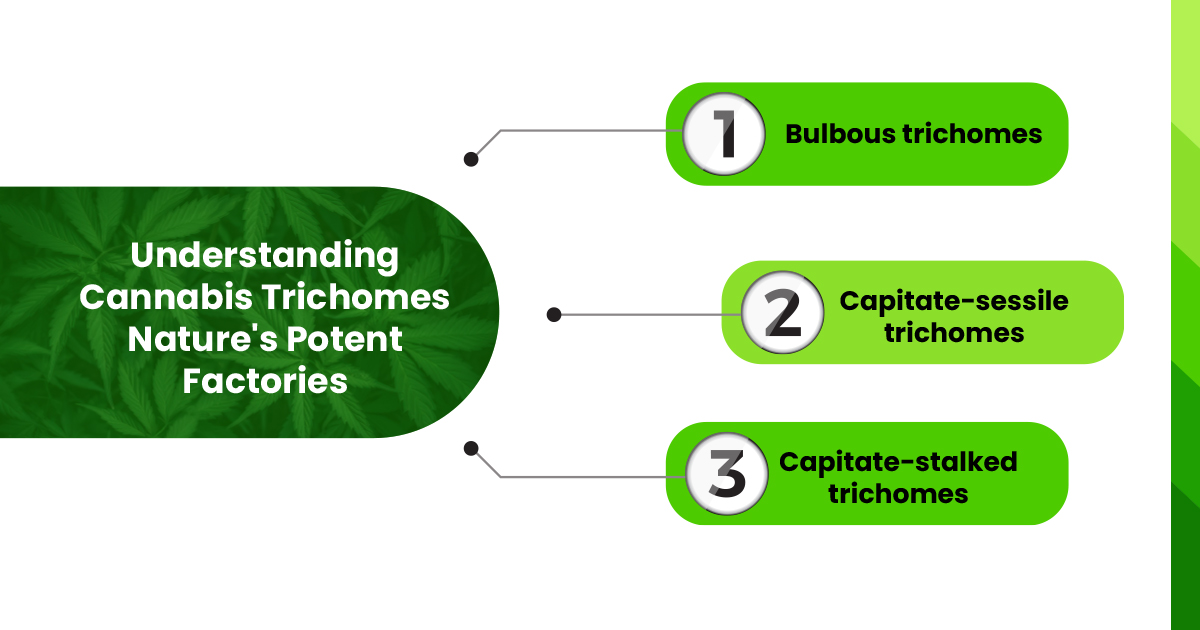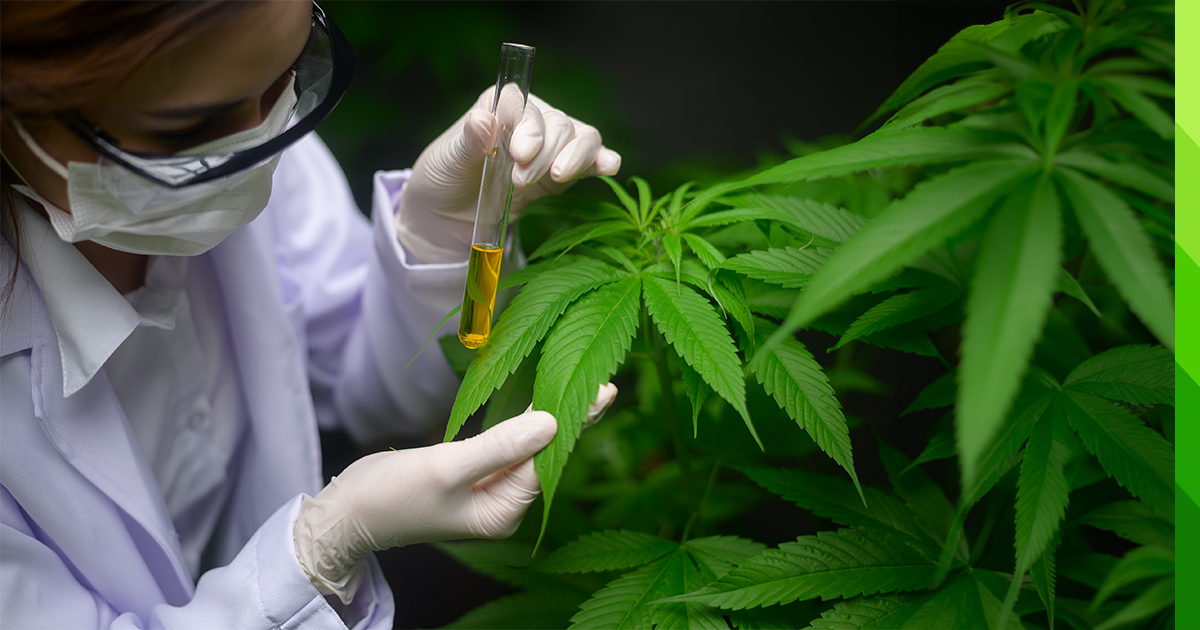Revealing the secrets of cannabis trichomes: Unfold their power and benefits
Brief Overview of Cannabis Trichomes

Tiny glands on the surface of cannabis plants called trichomes are essential to produce terpenes and cannabinoids. Different roles are played by varieties such as bulbous and capitate-sessile in this process. It is essential for producers and consumers to comprehend cannabis trichomes By evaluating trichome density and appearance to determine cannabinoid levels, it helps producers determine when to harvest. Recognizing how trichomes affect strain attributes like flavor, fragrance, and potency benefits consumers.
Importance of Understanding weed Trichomes
Understanding the functions of trichomes improves the experiences of growing and eating them. Producers may maximize yields for strength and quality, and users can choose wisely by considering trichome markers when choosing a strain.
What is Cannabis Trichomes?

Cannabis trichomes are the plants have tiny, hair-like structures called trichomes, which are essential to produce terpenes and cannabinoids. Three primary categories exist:
Bulbous trichomes: Round and tiny, these trichomes hold terpenes and essential oils that add to the scent of the plant.
Capitate-sessile trichomes: A little bigger and featuring a glandular head, these trichomes generate THC and CBD, two cannabinoids that affect the plant’s potency.
Capitate-stalked trichomes: These possess the highest concentration of terpenes and cannabinoids, which are essential for both scent and potency. A stalk supports a glandular head in these trichomes.
Visual characteristics and identification on cannabis plants
Examining these structures under a microscope is necessary for identification. While young cannabis trichomes are clear, adult ones have a transparent or milky white appearance. The density and maturity of trichomes influence the quality and effects of cannabis products by providing signs for the best time to harvest.
The Role of Trichomes on Weed
Biological Functions of Trichomes on Weed
Trichomes on weed perform various vital biological roles essential to their survival and development. These tiny structures generate and retain a wide range of substances, including terpenes and cannabinoids. These substances provide cannabis its unique scent and effects, but they also act as chemical barriers against infections and predators. Trichomes on weed also prevent UV rays, reflect sunlight, and decrease water loss, all of which contribute to the regulation of the plant’s temperature.
- Protection Against Pests and Environmental Stress: Trichomes serve as a strong barrier, keeping diseases, pests, and environmental stressors away from cannabis plants. Cannabis trichomes produce a sticky resin that can capture insects and repel herbivores. It also forms a physical barrier that protects the plant from wind, rain, and excessive sunshine. Furthermore, the chemical substances found in trichomes can ward off pests and prevent the formation of dangerous germs, protecting the health and vitality of the plant.
- Role in Reproduction: Trichomes are essential to cannabis plants’ ability to reproduce. The reproductive cells of the plant are found in the resin they create. Trichomes’ sticky surface attracts pollen, which makes pollination and fertilization easier. This procedure guarantees the continuation of the plant’s genetic lineage and is necessary for the development of seeds.
Contribution to the Plant’s Overall Health
Trichomes play a major role in the general resilience and health of cannabis plants. They control several physiological processes, such as nutrition intake, hydration retention, and defense mechanisms, by generating cannabinoids and terpenes. Stronger terpene and cannabinoid production is frequently associated with denser trichome covering, which in turn signifies a healthier and more potent plant. Trichomes also assist in preserving the plant’s homeostasis by reacting to stimuli and environmental cues, guaranteeing the plant’s existence and vitality.
Trichomes and Cannabinoid Production

Explanation of How Trichomes Produce Cannabinoids
The main location for cannabinoid synthesis is in the trichomes, which are the microscopic hair-like structures that cover the surface of cannabis plants. The glandular trichome heads, which are specialized cells within these glandular structures, house the biosynthetic enzymes that enable the synthesis of cannabinoids from precursor chemicals. By catalyzing intricate metabolic events, these enzymes change precursor molecules into a wide range of secondary metabolites, including terpenes and cannabinoids. The accumulation of these trichomes’ cannabinoids in their resinous secretions as they grow eventually adds to the cannabis plant’s strength and effects.
Overview of Key Cannabinoids Found in Trichomes
Although trichomes on cannabis yield a wide variety of cannabinoids, the most well-known and researched are THC (tetrahydrocannabinol) and CBD (cannabidiol). The euphoric effects of cannabis intake are mostly caused by THC, although CBD is well known for its possible therapeutic benefits, which include anti-inflammatory and pain-relieving actions. Additional cannabinoids, each having their own distinct effects and possible advantages, such CBC (cannabichromene) and CBG (cannabigerol), also add to the overall pharmacological profile of cannabis.
The Relationship Between Trichomes and the Potency of Cannabis:
Trichomes are an important factor in determining how potent cannabis is. The number of cannabinoids in trichomes is closely correlated with their size, density, and maturity. To harvest the plants at the height of their trichome cannabinoid production, cannabis cultivators frequently use the formation of trichomes as a sign when the plants are ready for harvesting. Trichomes that are mature and dense are important indicators of the quality and potency of cannabis strains since they indicate that the plant produced cannabis products with increased potency and noticeable effects.
The Benefits of Trichomes on Cannabis

- Enhancement of Cannabis Aroma and Flavor: Trichomes provide a variety of terpenes to cannabis, which improves the plant’s flavor and aroma. These fragrant ingredients produce a sensory experience with notes of fruit and soil.
- Importance in Determining Quality and Effects: Trichomes are markers of quality, with their maturity and density revealing the amount of terpene and cannabinoid content. This affects effects and potency, which helps consumers and growers choose the right strain.
- Function in Medicinal Properties: Terpenes and cannabinoids generated by trichomes play a part in the medicinal properties of cannabis, which include anti-inflammatory and pain-relieving properties. It is ideal to employ trichome-rich strains for medicinal purposes because of their interaction with the endocannabinoid system, which increases therapeutic efficacy.
Know how to examine and evaluate trichomes
Tools and Techniques for Examining Trichomes:
- Magnifying glass: Provides modest magnification for rapid evaluation.
- Microscope: Higher magnification is available using a microscope for a thorough examination of the trichome structure.
Trichome Maturity and Harvest Readiness Indicators
- Milky white appearance: A milky white color is indicative of ideal terpene and cannabinoid concentrations.
- Amber hue: Indicates over ripeness, whereas immaturity is indicated by clear trichomes.
Tips for Growers to Maximize Trichome Production:
- Provide the best possible environmental conditions, which should include enough light, nutrients, and humidity.
- Choosing strains with high trichome production helps in increasing potency and yield overall.
- Put pruning and training strategies into practice: Increase flowering locations’ exposure to light.
- Consistent monitoring allows for the maximum quality and potency of cannabis harvesting during the height of production.
Trichome Preservation and Extraction

Australia’s medical cannabis industry is at a nascent stage, with Delta 8 playing a potentially significant role. Its legal status and medical value are under continuous scrutiny, which will determine its future in the medical cannabis market.
Methods for Preserving Trichomes
- Gentle Handling: To prevent harming fragile trichomes, minimize physical irritation.
- Low Temperatures: To avoid trichome deterioration, keep processing and harvesting areas cold.
- Quick Processing: To maintain the freshness and potency of trichomes, process gathered material as soon as possible.
- Appropriate Storage: To avoid moisture loss and maintain the integrity of the trichome, store cannabis flowers or trim in airtight containers with humidity control.
Techniques for extracting trichomes for concentrates
- Dry Sifting: To remove cannabis trichomes from plant material, rub dried cannabis flowers or trim over screens.
- Ice Water Hash: To obtain trichome-rich hash, agitate cannabis in ice water until trichomes freeze. Then, filter the mixture.
- Solvent extraction: it is the process of dissolving cannabis trichomes in solvents such as butane or alcohol, then evaporating the solvent to yield concentrates like shatter or wax.
- Rosin Pressing: it’s the process of extracting trichomes and creating rosin concentrate by heating and pressing cannabis flowers or hash.
Advantages of products rich in cannabis trichome:
- Enhanced Potency: Products high in trichomes have concentrated amounts of terpenes and cannabinoids, which makes their effects more intense.
- Enhanced Aroma and Taste: Cannabis products with concentrated trichomes have richer, more nuanced scents and tastes.
- Versatility: Trichome weed extracts can be utilized to make a wide range of cannabis products, like as topicals, tinctures, and edibles, giving consumers a choice of ways to consume the plant.
- Therapeutic Potential: Products rich in cannabis trichomes may have more potent therapeutic effects, such as reduced tension, pain, and relaxation, due to their high terpene and cannabinoid concentrations.
Public Opinion and Controversies Surrounding Delta 8 in Australia
Public opinion on Delta 8 is divided. While some advocate for its low-risk profile and therapeutic potential, others are wary of its psychoactive nature and the lack of extensive research.
There is a controversy surrounding both the regulation of the cannabinoid and its legal status as well.
Conclusion
Trichomes are the main ingredient in cannabis, giving it its flavor, aroma, strength, and medicinal qualities. High-quality cannabis products are produced when trichomes are preserved during the harvesting and processing stages, which guarantees the retention of their beneficial ingredients. Concentrates with increased potency and adaptability can be produced by extracting trichomes weed using methods like solvent extraction, ice water hashing, and dry sifting. Products that are high in trichomes give consumers a variety of ways to consume them while still providing strong effects and mouthwatering flavors. Growers and consumers can maximize their cannabis experience by making educated decisions regarding product selection and harvest time by learning how to inspect and assess cannabis trichomes. Accepting the advantages of trichome-rich products increases enjoyment and allows cannabis to be fully used for both medical and recreational purposes possible.
FAQs
Frequently asked questions
What are the benefits of trichomes?
Trichomes offer several benefits, including protecting the cannabis plant from pests and environmental stress, enhancing the plant’s aroma and flavor through the production of terpenes, and determining the quality and potency of cannabis. They also play a significant role in the medicinal properties of cannabis by producing cannabinoids like THC and CBD.
What is the function of the trichome in cannabis?
Trichomes serve multiple functions in cannabis. They protect the plant from herbivores and UV rays, aid in the plant’s reproductive process by attracting pollinators, and help the plant manage environmental stress. Additionally, trichomes are the primary sites for the production of cannabinoids and terpenes, which are crucial for the plant’s medicinal and recreational value.
What are cannabis trichomes and how do they affect your smoke?
Cannabis trichomes are small, hair-like structures on the surface of the cannabis plant that produce and store cannabinoids, terpenes, and flavonoids. They affect your smoke by determining the potency, flavor, and aroma of the cannabis. High-quality cannabis with abundant trichomes tends to have a more potent effect and a richer sensory experience.
What are the 5 functions of trichomes?
- Protection Against Pests: Trichomes produce compounds that deter herbivores.
- UV Protection: They shield the plant from harmful ultraviolet rays.
- Reproductive Support: Trichomes attract pollinators and protect reproductive organs.
- Environmental Stress Management: They help the plant cope with extreme temperatures and humidity.
- Production of Active Compounds: Trichomes are the primary sites for cannabinoid and terpene synthesis.
How do trichomes produce cannabinoids?
Trichomes produce cannabinoids through specialized glandular cells located in their heads. These cells synthesize cannabinoids like THC and CBD from precursor compounds through a series of biochemical reactions. The cannabinoids are then stored in the resin produced by the trichomes, which can be harvested for consumption.
What is the difference between terpenes and trichomes?
Trichomes are the small, hair-like structures on the cannabis plant that produce and store various compounds, including cannabinoids and terpenes. Terpenes, on the other hand, are the aromatic compounds produced within the trichomes. While trichomes are the physical structures, terpenes are the chemical compounds responsible for the plant’s aroma and contribute to its therapeutic effects.
Step into a world of relief with CannaAid’s dedicated approach to natural pain management.
We’re committed to alleviating suffering through plant-based medicine and providing a haven for those ready to break free from the restrictions of traditional medicine.








